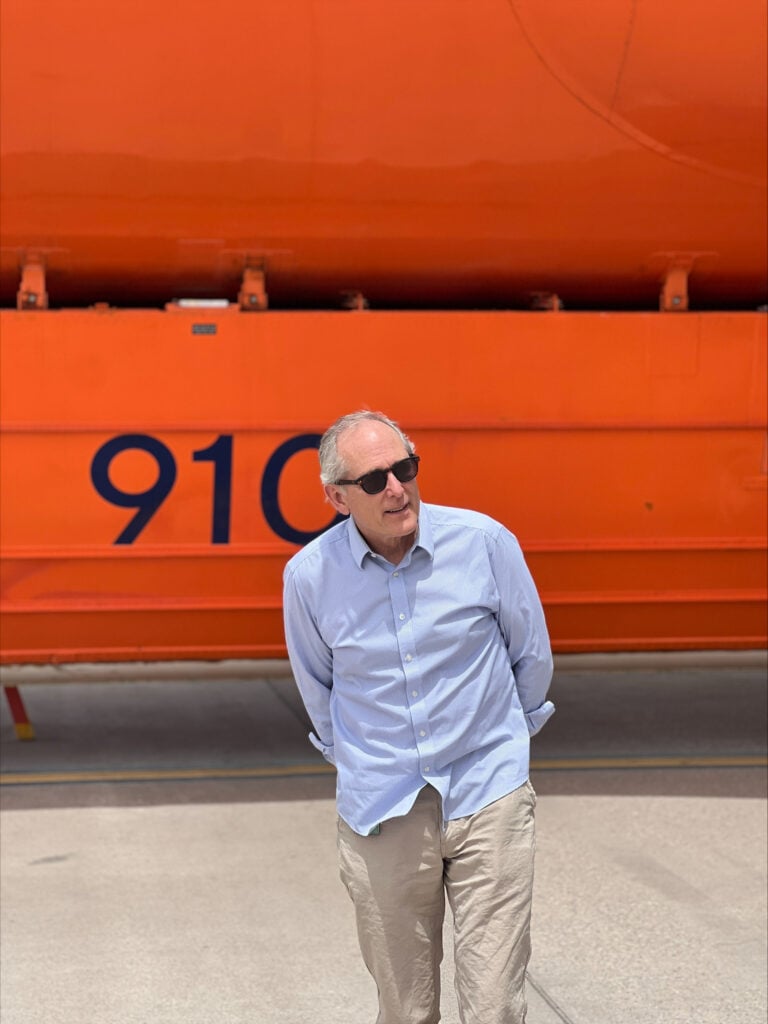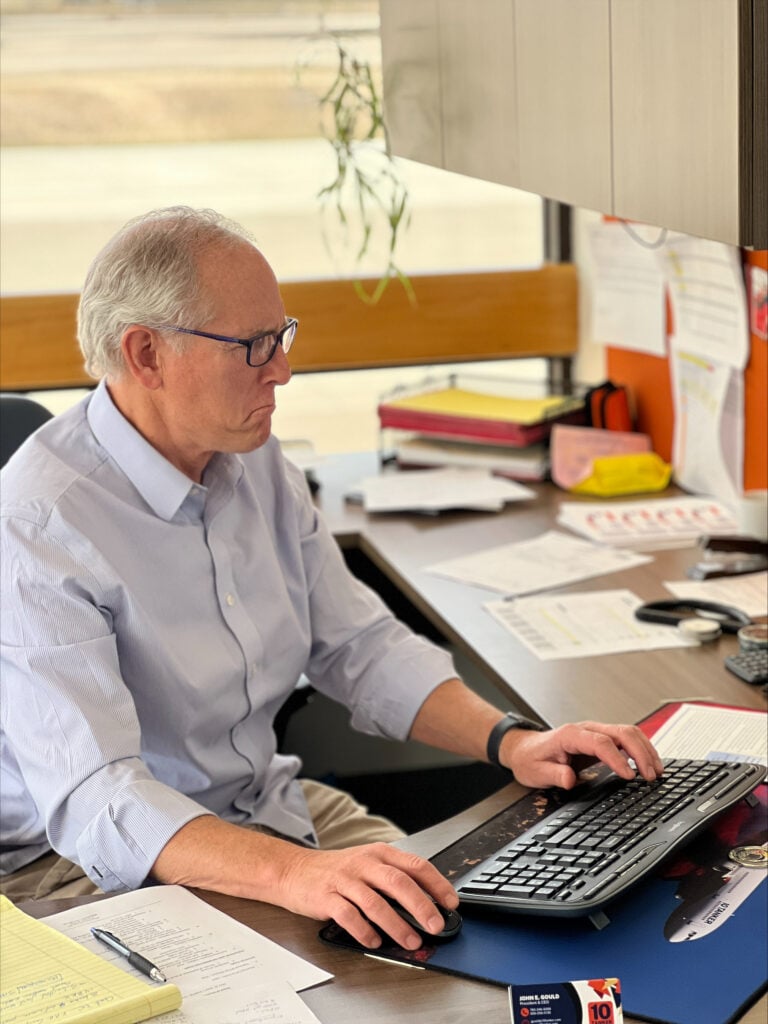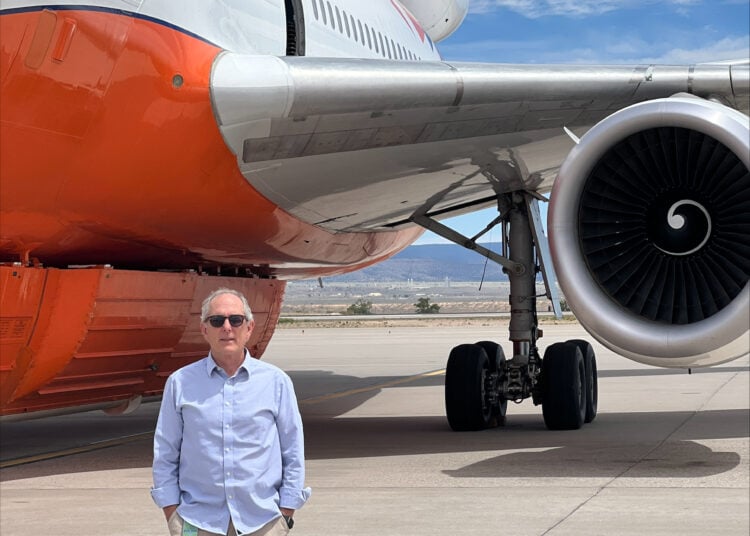AerialFire recently caught up with John Gould to talk about his career in the aerial firefighting industry and his path to becoming the CEO of the only VLAT air tanker company, New Mexico-based 10 Tanker Air Carrier.
AF: Many would say you had a very immersive career in the industry. Can you tell us how you got your start in fire?
JG: I was a freshman in college, and there was a guy who lived on my wing with all these pictures of what he did as a firefighter in Alaska. And there were helicopters, and I was sold. At the time, I was working for a buck and a quarter an hour at a tree farm, and I told myself I needed to get into that. So, at age 19, I applied and got hired by the Bureau of Land Management in Alaska as a total newbie to work on an engine.

AF: What was your career progression from that first job to where you are now?
JG: I worked in Alaska for four or five years, working in different capacities, such as on helitack crews and engines. After five years of that, I became a rookie smokejumper for BLM Alaska in 1981. They sent us down to Idaho, and then I went to Montana. That was the great thing about smoke jumping: you went all over the country, jumped out every base, and got to know all these different people, different fuel models, and various fire behaviors, along with seeing many great parts of the country. That was the next 20 years of my career.
AF: How did you transition from a smoke jumper into the next stage of your career?
JG: 1999 was the last year I worked as an Alaska smoke jumper. The Alaska jumpers were one of the only jump bases at the time that encouraged their guys to get different training. We had a lot of air tankers coming in and dropping, so you learned how to control air tankers. If they like you and you have the leadership skills, they make you a smokejumper spotter. So, that was my introduction to aerial supervision. As a jumper, you have to be qualified up to division group supervisor to be an ATGS, so I became qualified as an ATGS.
In Alaska, back in the day, the ATGS flew with the lead planes, so there was a lot of experience flying leads and with the lead plane pilots. I also performed para cargo. Over my career, I have kicked millions of pounds of cargo out of the back of big planes like an Argosy and a C-130. If there was anything in my career that was potentially going to kill me, it was definitely working para cargo, but we all made it out okay.
AF: Was there a period in your career where you pivoted from adventure to a part of your career that was more stable with less of a dangerous element, like a smoke jumper?
JG: I was still jumping at age 41, but at that age, I also had a wife and kids, so something needed to happen because I like adventure, but that wasn't really working that well for family life, so I became a Fire Management Officer for the military lands, so I was the FMO for a short period before I applied for a job as the Fire and Aviation manager for the Bureau of Indian Affairs in Boise in 1999. For six years, I was the fire and aviation safety guy for the Bureau of Indian Affairs at their national office, and that gave me an introduction to how the sausage was made at NIFC.

I spent half a dozen years there and ended up on many great committees that all concerned fire and aviation safety. At the time, those issues were becoming bigger parts of the programs, so I got a front-row seat and had a chance to develop some national initiatives.
I was lucky enough to be part of the team that reformed the federal Fire and Aviation Safety Team. I was the chair of that team, and I got all the safety people from all the agencies to meet once a month and create initiatives. We created Six Minutes for Safety and SafeNet, many of which are still around and working today.
AF: What was your favorite agency role?
JG: Of everything I've ever done, working for the Bureau of Indian Affairs was one of the most fun roles I’ve had. I really liked the people and working in some of the most beautiful parts of the country. People don't appreciate what a great country we have, how beautiful it is on the Indian reservations, what great people they are, and what great firefighters they are. So it was a real education for me to be a part of that.
AF: After Indian Affairs, you moved back to Alaska. Can you tell us more about that?
In 2005, I was encouraged to apply for a job as the manager of the Alaska Fire Service, so I went back up to Alaska for the next five years and managed a large operation that had a smokejumper base, a couple of hotshot crews, type two crews, a warehouse, a mess hall, and barracks along with a coordination centers. I grew up there, so I knew the state, and having worked there previously, I had a working relationship; thanks to my previous work jumping in Alaska, it made the job more enjoyable and more manageable with those previous relationships already established.
AF: At what point did you switch to the more aviation-based role?
JG: In 2011, I became the head of air operations for the Bureau of Land Management. At the time, we had only five old Beechcraft lead planes and pilots.

AF: What were some of the achievements in your time there?
JG: When you run an organization, you look for opportunities to improve it, take those opportunities, and don't let them pass. We only had five lead planes, and we knew we had to improve that, so we were talking about citations, which we brought online. They were greatly successful. We were also looking at improving our fleet of helicopters, so instead of bringing on older Bell 205s, we brought the first Black Hawk into the DOI.
AF: How did you transition from the federal world into a role with 10 Tanker?
JG: I was doing a stint in DC in 2012 and met with the folks at 10 Tanker. I thought they were friendly folks, but in my mind, at the time, I did not consider the DC-10 as a relevant asset. At the time, trying to sell a DC-10 to the fire world was a big project, and I didn't give it much thought, but we had a pleasant conversation, and they stayed in touch.
At the time, 10 Tanker had CWN contracts. That was when the rest of the world was struggling to find next-gen aircraft that they could get on to contract as the old legacy air tankers were going away. So we were hurting for aircraft; they were around with CalFire and on CWN with the Forest Service. So I got on one of their airplanes with one of our lead plane pilots down in Arizona.
Kevin Hoff was flying the DC-10, and they put a ring around that fire with a column that went up to 10,000 feet quickly. I've seen lots and lots of fire from airplanes, and they put a ring around that fire and stopped. It blew me away. I could not believe what I was seeing. Watching it be such an effective use of retardant and the great line it dropped, I became a DC-10 believer.
So then, when they came back to me when I was still the head of aviation for the BLM, I had a completely different outlook on their effectiveness, and they were granted contracts.
AF: In 2013, you left federal service and joined 10 Tanker. Did you immediately start as the head of the organization?
JG: When I left BLM to join 10 Tanker, based on my background, I joined as their business development manager. After several years developing business for the company, still working out of my home in Boise, the board asked me in 2017 to come to Alberquerque for six weeks to help the business transition as they searched for a new CEO.
That six weeks then became a request for a few more months before the board eventually asked me to become CEO in late 2017, which I have been doing ever since.
AF: As far as contracts for 10 Tanker go, is it reasonably cyclical for the business?
JG: When I came on board as CEO, there were three DC-10s, with the fourth coming online. We have had several 10-year contracts, which are now ended, but the company has always worked a mix of exclusive use contracts and CWN contracts both in the U.S. and abroad. The aircraft has been used overseas in Australia, Chile, and Mexico over the years and here, which we hope will continue with the global need for firefighting increasing.
AF: Over all the years you have worked in the industry, what do you think is one of the larger achievements of your career?

JG: The national initiatives we started were significant, but I don't think anybody in the fire world knows about them or who started them. But I'm glad that I did it. I'm most definitely proud that 10 Tanker is a highly functioning company right now. We're only four planes, but we keep our customers and employees happy. I'm proud of what I did there.
I hope that one day, I can say that I was one of the founders of UAFA and that I was right there with everyone else when we started it. I think that someday, that is something that I hope we will all be proud of; I think it was necessary, and the benefits that UAFA can bring to our industry will be immense.
AF: So the word is that you will be retiring at the end of the year?
JG: Yeah. So that's the plan. You know, I mean, when I hired Joel Kerly, the idea was that Joel would take over for me, and he has had a couple of years to learn about the company and understand what he was supposed to do. I think he will do great in the role. So, at the end of this year, it'll have been two years he’s been here, and I think I've been around long enough. I'll be 68 and a half when it comes time to retire. And that's plenty of time to have been hanging around. My wife will also be retiring, so I figure it's time to do everything I've never had time to do.






